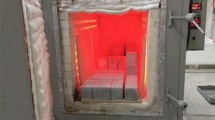Abstract
Low-heat, ultralow-shrinkage, and high strength zero-cement concrete referred to as Sustain Crete-Zero (STC-Zero) has been developed [1,2,3,4,5]. While containing no cement, its binder comprises powders generally used for concrete: ground granulated blast-furnace slag, fly ash, silica fume, and an expansive additive. Thanks to its low-heat, ultralow-shrinkage, and high strength characteristics, STC-Zero drastically reduces the risk of cracking and enhances the durability of concrete structures. In other words, STC-Zero is a promising new construction material capable of reducing not only CO2 emissions at early stages but also life cycle CO2 (LCCO2) including maintenance and renewal. This study focused on and experimentally examined the temperature dependence tendencies of the strength development of STC-Zero among its characteristics. To be specific, the strength of cores drilled from block specimens exposed outdoors and the indoor strength development under different temperature conditions were confirmed. As a result, it was found that (1) the strength gains of STC-Zero are greater at high temperatures and smaller at low temperatures than conventional concrete made using Portland cement; and (2) the strength development of STC-Zero cannot be uniformly evaluated by the generally adopted maturity factor based on equivalent age. The reason for this is discussed, focusing on the apparent activation energy at different equivalent ages.
Access this chapter
Tax calculation will be finalised at checkout
Purchases are for personal use only
Similar content being viewed by others
References
Matsuda T, Noguchi T, Kanematsu M, Mine R (2018) Ultralow shrinkage and high strength concrete without Portland cement. In: Proceedings of the fib congress, pp 973–983
Matsuda T, Mine R, Geddes DA, Walkley B, Provis JL (2022) Development of ultra-low shrinkage and high strength concrete without Portland cement with experimental study on its fabrication. In: Proceedings of the fib congress, pp 763–772
Shinozaki H, Matsuda T, Kasuga A (2022) Construction of non-metallic bridge using zero-cement concrete. In: Proceedings of the fib congress, pp 2488–2497
Going cement-free: tested concrete girder makes it into a bridge in Japan (2019) Bride Design & Engineering, Issue No 96 Third Quarter, pp 64–65
Matsuda T, Geddes DA, Walkley B, Provis J L (2020) Properties and microstructure of ultralow shrinkage and high strengh Zero-Cement-Concrete. In: Proceedings of the fib
Tomosawa F, Ushijima S (1991) Recentry study on the development and apprication of maturity. Cem Concr 527:66–74
Itoh K, Kishi T, Uomoto T (2002) The microstructure of the hardened cement paste formed in various curing temperatures. Proc Jpn Concr Inst 24(1):489–494
Fib (2010) fib Model Code for Concrete Structures p 94
Japan Society of Civil Engineers (2017) Standard Specifications For Concrete Structtures, Design, p 110
Carino NJ, Tank RC (1992) Maturity functions for concrete made with various cements and admixtures. ACI Mater J 89(2):188–196
Zhang JY, Cusson D, Monteriro P, Harvey J (2008) New perspectives on maturity method and approach for high performance concrete applications. J Cem Concr Res 38(12):1438–1446
Kiriyama, H, et al (2019) study on temperature dependence and estimation method of high strength mortar using alite cement and pozzolanic fine powder. J Jpn Soc Civil Eng Ser E2 (Mater Concr Struct) 75(3):157–168
Author information
Authors and Affiliations
Corresponding author
Editor information
Editors and Affiliations
Rights and permissions
Copyright information
© 2023 The Author(s), under exclusive license to Springer Nature Switzerland AG
About this paper
Cite this paper
Matsuda, T., Mine, R., Noguchi, T. (2023). Temperature Dependence Tendency of the Strength Development of Ultra-Low-Shrinkage and High-Strength Zero-Cement Concrete. In: Ilki, A., Çavunt, D., Çavunt, Y.S. (eds) Building for the Future: Durable, Sustainable, Resilient. fib Symposium 2023. Lecture Notes in Civil Engineering, vol 349. Springer, Cham. https://doi.org/10.1007/978-3-031-32519-9_38
Download citation
DOI: https://doi.org/10.1007/978-3-031-32519-9_38
Published:
Publisher Name: Springer, Cham
Print ISBN: 978-3-031-32518-2
Online ISBN: 978-3-031-32519-9
eBook Packages: EngineeringEngineering (R0)




